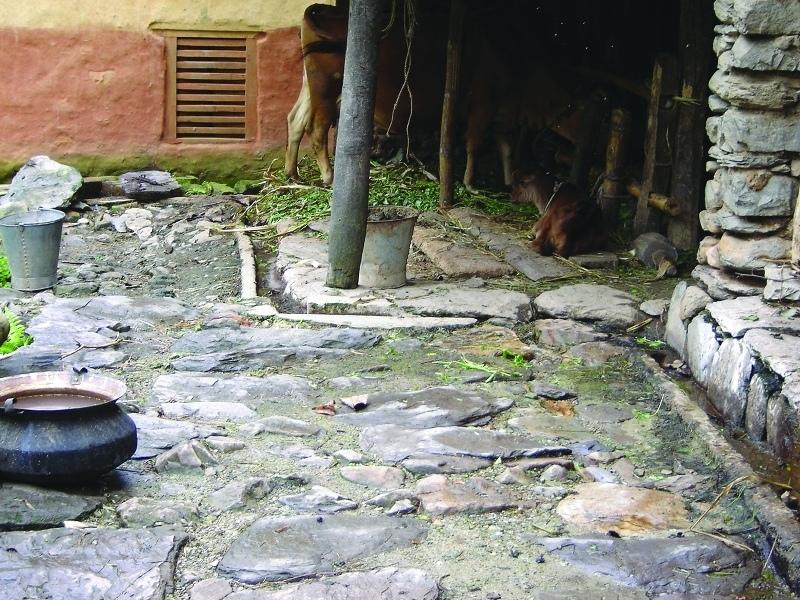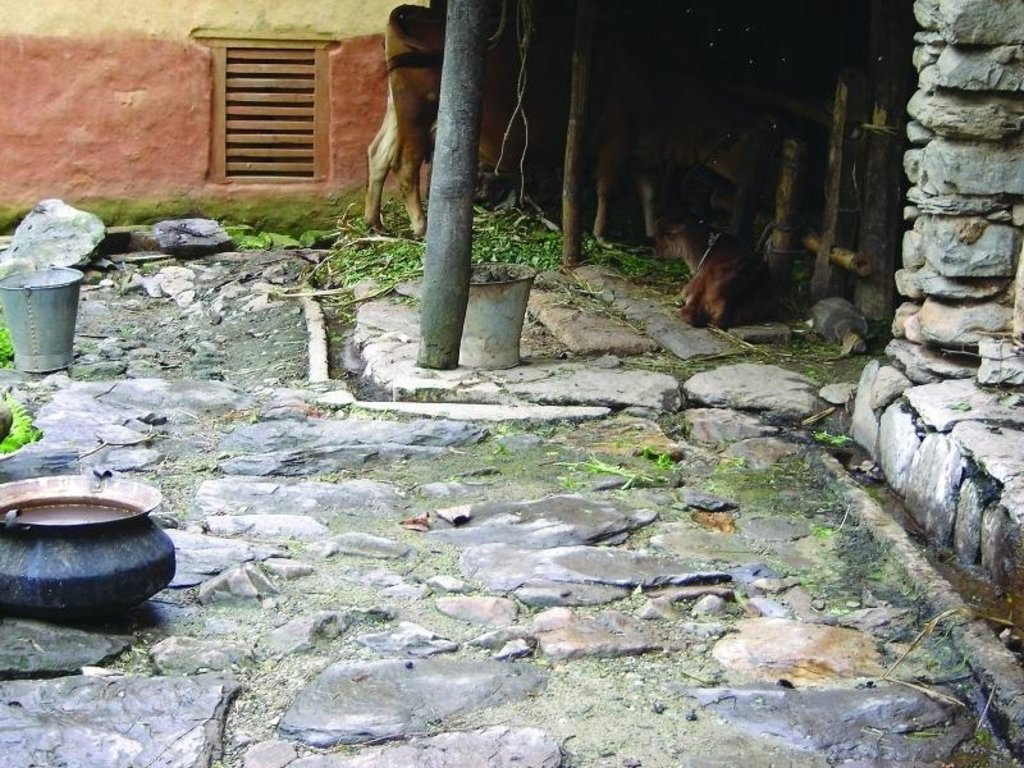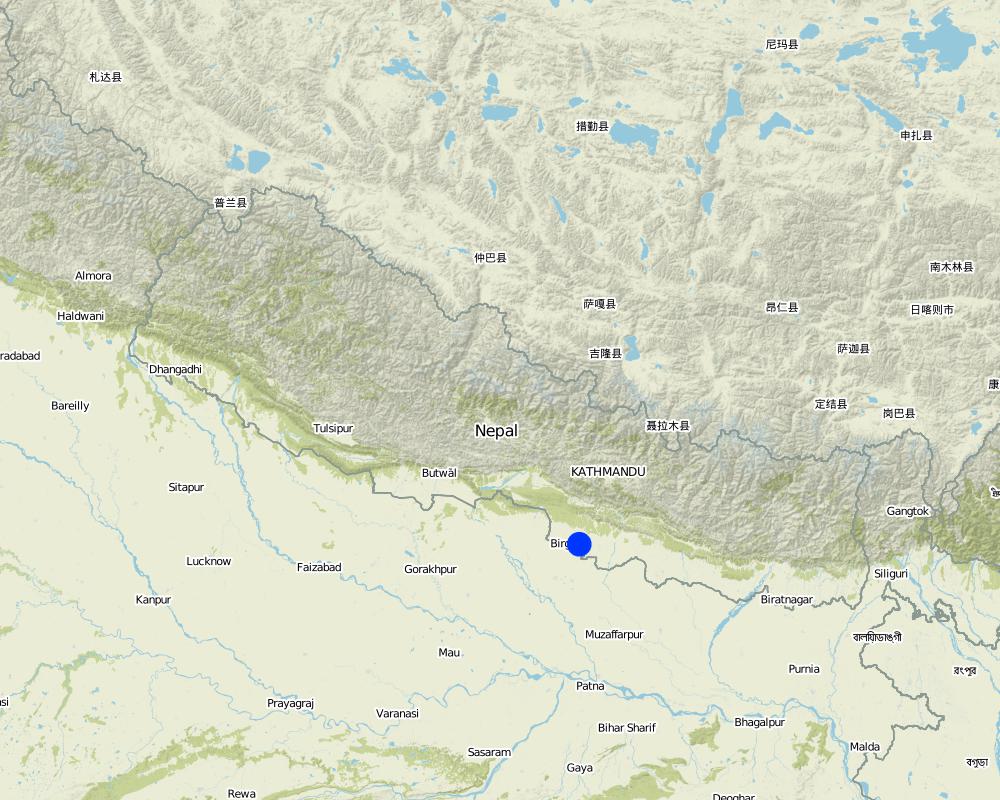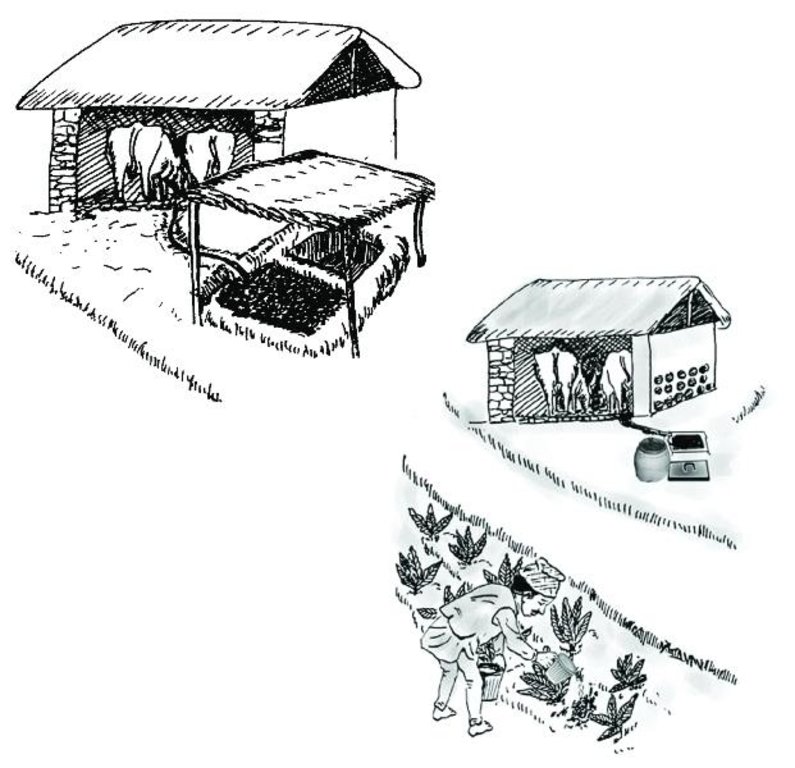Improved cattleshed for urine collection [Nepal]
- Criação:
- Atualização:
- Compilador/a: Richard Allen
- Editor: –
- Revisores: David Streiff, Alexandra Gavilano
Mutra sankalan ka lagi sudhariyeko goth (Nepali)
technologies_1752 - Nepal
Veja as seções
Expandir tudo Recolher tudo1. Informação geral
1.2 Detalhes do contato das pessoas capacitadas e instituições envolvidas na avaliação e documentação da tecnologia
Especialista em GST:
Director
Soil Management Directorate, Department of Agriculture
Nepal
Especialista em GST:
Team Leader
Sustainable Soil Management Programme
Nepal
Nome do projeto que facilitou a documentação/avaliação da Tecnologia (se relevante)
Sustainable Soil Management Programme, Nepal (SSMP)Nome da(s) instituição(ões) que facilitou(ram) a documentação/ avaliação da Tecnologia (se relevante)
HELVETAS (Swiss Intercooperation)Nome da(s) instituição(ões) que facilitou(ram) a documentação/ avaliação da Tecnologia (se relevante)
Department of Agriculture, Soil Management Directorate, Hariharbhawan Lalitpur (doasoil) - Nepal1.3 Condições em relação ao uso da informação documentada através de WOCAT
O compilador e a(s) pessoa(s) capacitada(s) aceitam as condições relativas ao uso de dados documentados através do WOCAT:
Sim
1.5 Referência ao(s) questionário(s) sobre abordagens GST (documentado(s) usando WOCAT)

Farmer field schools on integrated plant nutrient systems [Nepal]
Participatory and collaborative learning through the farmer field school approach
- Compilador/a: Richard Allen
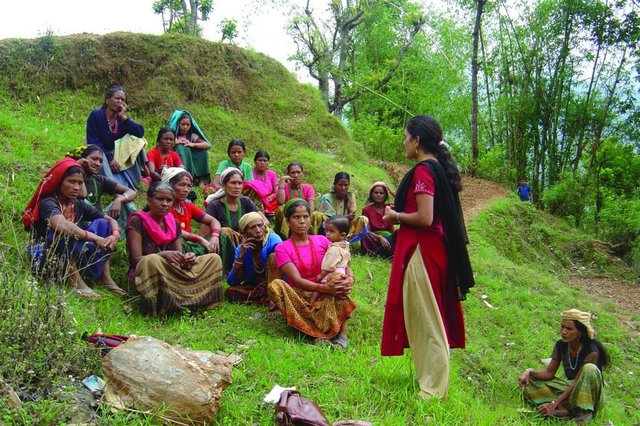
Farmer-led experimentation [Nepal]
Participatory technology testing and adaptation through farmer-led experiments
- Compilador/a: Richard Allen

Farmer-to-farmer diffusion [Nepal]
Wider diffusion of sustainable soil management technologies through a demand responsive farmer-to-farmer diffusion approach
- Compilador/a: Richard Allen
2. Descrição da tecnologia de GST
2.1 Descrição curta da tecnologia
Definição da tecnologia:
Collection of cattle urine in improved cattle sheds for use as liquid manure and organic pesticide
2.2 Descrição detalhada da tecnologia
Descrição:
Nitrogen is the most important macronutrient for plants, and high crop productivity can only be achieved by making sufficient nitrogen available to crops. Nitrogen is also the most limiting nutrient in farms across Nepal’s midhills. Traditionally farmers applied farmyard manure to fertilise their needs. In many places this is being supplemented or even entirely replaced by inorganic fertiliser - mainly urea. The price of inorganic fertiliser has increased continuously in recent years and it is only available in limited quantities in areas far from the roadheads. On the other hand, cultivation practices are intensifying with increased cropping intensities and more nutrient-demanding crops as, for example, local varieties are replaced by hybrids and new crops are grown. This can easily lead to declining soil fertility and nutrient mining if it is not compensated for by an equivalent increase in organic or mineral fertilisation.
Cattle urine is a viable alternative to mineral fertiliser. Of the nitrogen excreted by cattle, 60% is found in the urine and only 40% in dung. In traditional sheds, urine is left to be absorbed in the bedding material, while excess urine is channelled out of the shed and disposed of. The technology described here - improved cattle sheds- are designed for collecting the urine in a pit or drum. This pit is generally located in the shed itself or just outside connected to the drainage channel through a pipe and protected from rain and runoff. Where urine is collected for incorporation in farmyard manure, the pit may be directly connected to the manure pit or heap. Urine that is going to be used as liquid manure or organic pesticide has to be stored in a drum for fermentation.
A household with two cattle can save the equivalent of purchasing about 100 kg of urea over one year by applying urine either directly as liquid fertiliser or as a component in improved farmyard manure.
2.3 Fotos da tecnologia
2.5 País/região/locais onde a tecnologia foi aplicada e que estão cobertos nesta avaliação
País:
Nepal
Especificação adicional de localização:
Midhill districts of Nepal
Map
×3. Classificação da tecnologia de GST
3.1 Principal/principais finalidade(s) da tecnologia
- Collect fertilizer
3.2 Tipo(s) atualizado(s) de uso da terra onde a tecnologia foi aplicada

Terra de cultivo
- Cultura anual
Comentários:
Major land use problems (compiler’s opinion): Intensifying cultivation practices with either 1) inadequate application of fertilisers leading to a decline in soil fertility and the mining of soil nutrients or 2) application of too much fertiliser causing environmental problems through excessive leaching, and losses of fertiliser in surface runoff and consequent eutrophication or nitrification of streams, ponds, or groundwater.
3.5 Grupo de GST ao qual pertence a tecnologia
- Gestão integrada de fertilidade do solo
3.6 Medidas de GST contendo a tecnologia

Medidas de gestão
- M6: Gestão de resíduos (reciclagem, reuso ou redução)
Comentários:
Main measures: management measures
3.7 Principais tipos de degradação da terra abordados pela tecnologia

Deteriorização química do solo
- Cn: declínio de fertilidade e teor reduzido de matéria orgânica (não causado pela erosão)
3.8 Redução, prevenção ou recuperação da degradação do solo
Especifique o objetivo da tecnologia em relação a degradação da terra:
- Não aplicável
4. Especificações técnicas, implementação de atividades, entradas e custos
4.1 Desenho técnico da tecnologia
Especificações técnicas (relacionada ao desenho técnico):
a) Urine collection and direct incorporation in covered farmyard manure pit.
b) Urine collection for later application as liquid manure or organic pesticide.
Technical knowledge required for field staff / advisors: low
Technical knowledge required for land users: low
Main technical functions: increase in organic matter, increase in soil fertility, increase in soil productivity, pest control
Secondary technical functions: supplementary irrigation
4.2 Informação geral em relação ao cálculo de entradas e custos
Especifique como custos e entradas foram calculados:
- Por unidade de tecnologia
Especifique a unidade:
Urine collection system
Especifique a moeda utilizada para os cálculos de custo:
- USD
Indique a média salarial da mão-de-obra contratada por dia:
2.00
4.3 Atividades de implantação
| Atividade | Periodicidade (estação do ano) | |
|---|---|---|
| 1. | Provide slight slope to the cattle shed floor | |
| 2. | Dig a draining ditch and a collection pit, if possible at the lowest point inside the shed. If this is not possible, an outside pit should be dug, protected from rain and runoff, and connected with the draining ditch through a pipe or a channel. | |
| 3. | Make the floor as impermeable as possible; e.g. with cement (expensive and durable), stone slabs, soil compaction, or clay (cheap but not durable). The more impermeable the floor, the more urine can be collected. | |
| 4. | Provide a jug/’decapitated’ plastic bottle/cup/etc. to scoop the urine out of the collection pit into the fermentation drum. |
4.4 Custos e entradas necessárias para a implantação
| Especifique a entrada | Unidade | Quantidade | Custos por unidade | Custos totais por entrada | % dos custos arcados pelos usuários da terra | |
|---|---|---|---|---|---|---|
| Mão-de-obra | Labour | per unit | 1,0 | 6,0 | 6,0 | 100,0 |
| Material de construção | Plastic drum | per unit | 6,0 | 1,0 | 6,0 | 100,0 |
| Custos totais para a implantação da tecnologia | 12,0 | |||||
| Custos totais para o estabelecimento da Tecnologia em USD | 12,0 | |||||
Comentários:
Duration of establishment phase: 0.25 month(s)
4.5 Atividades recorrentes/manutenção
| Atividade | Periodicidade/frequência | |
|---|---|---|
| 1. | When the collection pit is full, the collected urine has to be removed from the pit and stored in a plastic drum for fermentation. | |
| 2. | The urine is applied as liquid fertiliser by jug or through drip irrigation. |
4.6 Custos e entradas necessárias pata a manutenção/atividades recorrentes (por ano)
Comentários:
It is clear that cattle or buffaloes are required for urine production. To help farmers to use their own resources, it is suggested to start with the cheapest and simplest form of urine collection and a compacted sloping floor and a collection pit within the shed. This allows the farmer to see the benefits of collecting the urine and will encourage them to invest in more expensive materials to improve the efficiency of urine collection. Cost as in January 2007
5. Ambiente natural e humano
5.1 Clima
Precipitação pluviométrica anual
- <250 mm
- 251-500 mm
- 501-750 mm
- 751-1.000 mm
- 1.001-1.500 mm
- 1.501-2.000 mm
- 2.001-3.000 mm
- 3.001-4.000 mm
- > 4.000 mm
Especificações/comentários sobre a pluviosidade:
Annual rainfall: Also 2000-3000 mm
Zona agroclimática
- úmido
Thermal climate class: subtropics
5.2 Topografia
Declividade média:
- Plano (0-2%)
- Suave ondulado (3-5%)
- Ondulado (6-10%)
- Moderadamente ondulado (11-15%)
- Forte ondulado (16-30%)
- Montanhoso (31-60%)
- Escarpado (>60%)
Formas de relevo:
- Planalto/planície
- Cumes
- Encosta de serra
- Encosta de morro
- Sopés
- Fundos de vale
Zona de altitude:
- 0-100 m s.n.m.
- 101-500 m s.n.m.
- 501-1.000 m s.n.m.
- 1.001-1.500 m s.n.m.
- 1.501-2.000 m s.n.m.
- 2.001-2.500 m s.n.m.
- 2.501-3.000 m s.n.m.
- 3.001-4.000 m s.n.m.
- > 4.000 m s.n.m.
Comentários e outras especificações sobre a topografia:
Slopes on average: Also moderate (6-10%), rolling (11-15%) and hilly (16-30%)
Landforms: Also footslopes
Altitudinal zone: Also 1000-1500 m a.s.l. and 1500-2000 m a.s.l.
5.6 Características dos usuários da terra que utilizam a tecnologia
Orientação de mercado do sistema de produção:
- Subsistência (autoabastecimento)
- Comercial/mercado
Indivíduos ou grupos:
- Indivíduo/unidade familiar
Indique outras características relevantes dos usuários da terra:
Off-farm income specification: In most farm households, off-farm income plays at least a minor and increasingly a major role. Occasional opportunities for off-farm income present themselves in the form of daily labour wages. Some households’ members receive regular salaries, whilst an increasing number of Nepalis are working in India, the Middle East, Malaysia, and elsewhere and sending remittance incomes home.
5.7 Área média de terrenos utilizados pelos usuários de terrenos que aplicam a Tecnologia
- < 0,5 ha
- 0,5-1 ha
- 1-2 ha
- 2-5 ha
- 5-15 ha
- 15-50 ha
- 50-100 ha
- 100-500 ha
- 500-1.000 ha
- 1.000-10.000 ha
- > 10.000 ha
5.8 Propriedade de terra, direitos de uso da terra e de uso da água
Propriedade da terra:
- Indivíduo, não intitulado
- Indivíduo, intitulado
Direitos do uso da terra:
- Arrendado
- Indivíduo
6. Impactos e declarações finais
6.1 Impactos no local mostrados pela tecnologia
Impactos socioeconômicos
Renda e custos
Despesas com insumos agrícolas
Comentários/especificar:
Reduced expenses for agrochemicals
Outros impactos socioeconômicos
Shed management and cleaning
Organic crop production
Animal health
Establishment costs if cement is used
Impactos socioculturais
Social prestige as seen as progressive farmer
Handling of dung and urine
Impactos ecológicos
Outros impactos ecológicos
Eutrophication and nitrification of waterbodies due to controlled outflow of urine
6.2 Impactos externos mostrados pela tecnologia
Poluição de água subterrânea/rio
Comentários/especificar:
Reduction of nutrient influx into water bodies
Dependence on outside inputs
6.4 Análise do custo-benefício
Como os benefícios se comparam aos custos de implantação (do ponto de vista dos usuários da terra)?
Retornos a curto prazo:
positivo
Retornos a longo prazo:
positivo
Como os benefícios se comparam aos custos recorrentes/de manutenção(do ponto de vista dos usuários da terra)?
Retornos a curto prazo:
positivo
Retornos a longo prazo:
positivo
Comentários:
The high cost of mineral fertiliser means that the establishment costs are soon recovered. In the long-term, the major reduction in fertiliser cost leads to increased benefits.
6.5 Adoção da tecnologia
Comentários:
Comments on spontaneous adoption: Approximately 30% of SSMP supported farmers groups and about 15% none members of SSMP supported groups adopted the tehnology.
6.7 Pontos fortes/vantagens/oportunidades da tecnologia
| Pontos fortes/vantagens/oportunidades na visão do compilador ou de outra pessoa capacitada |
|---|
|
The use of urine collected on-farm reduced the requirement for mineral fertiliser which reduced production costs and outside dependency How can they be sustained / enhanced? Further promotion of the technology will increase this impact |
|
Human urine can also be used to fertilise crops, but needs to be fermented longer and may be socially less accepted How can they be sustained / enhanced? Promote the use of urine further and show there is no problem with using human urine |
|
Applying urine as a liquid manure also irrigates the crops (fertigation) How can they be sustained / enhanced? The link between urine application and drip irrigation, or other forms of smallscale irrigation, should be promoted. It has been tested and applied successfully by farmers related to SSMP in Syangja and Surkhet in western Nepal |
6.8 Pontos fracos, desvantagens/riscos da tecnologia e formas de superá-los
| Pontos fracos/vantagens/riscos na visão do compilador ou de outra pessoa capacitada | Como eles podem ser superados? |
|---|---|
| The initial costs incurred whilst improving a durable shed using cement may hinder adoption | Simpler methods such as using clay soil, compacting the fl oor, and using stone slates may, however lead to less urine being collected |
| Project incentives (cement, plastic drum) have hindered adoption in some places |
No incentives should be provided, rather very simple methods should be demonstrated and adapted to local conditions |
| Urine collection is feasible for subsistence farm households or small scale commercial producers. It may, however, not be applicable for larger scale commercial vegetable producers as a balance between area needed for livestock and growing the crops is needed | Urine could become a tradeable commodity which would see large-scale livestock producers selling their urine to large-scale vegetable producers. |
7. Referências e links
7.1 Métodos/fontes de informação
7.2 Referências às publicações disponíveis
Título, autor, ano, ISBN:
STSS; SSMP (2001) Farmyard Manure and Compost Management (in Nepali). Kathmandu: Soil Testing Services Section, Department of Agriculture and Sustainable Soil Management Programme
Disponível de onde? Custos?
SSMP
Links e módulos
Expandir tudo Recolher tudoLinks

Farmer field schools on integrated plant nutrient systems [Nepal]
Participatory and collaborative learning through the farmer field school approach
- Compilador/a: Richard Allen

Farmer-led experimentation [Nepal]
Participatory technology testing and adaptation through farmer-led experiments
- Compilador/a: Richard Allen

Farmer-to-farmer diffusion [Nepal]
Wider diffusion of sustainable soil management technologies through a demand responsive farmer-to-farmer diffusion approach
- Compilador/a: Richard Allen
Módulos
Não há módulos


